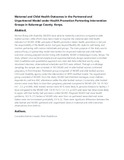| dc.contributor.author | Lusweti, Consolata Namisi | |
| dc.contributor.author | Nandikove, Peter | |
| dc.date.accessioned | 2021-07-15T09:14:07Z | |
| dc.date.available | 2021-07-15T09:14:07Z | |
| dc.date.issued | 2020-11-11 | |
| dc.identifier.uri | https://doi.org/10.21275/SR201107113937 | |
| dc.identifier.uri | https://www.ijsr.net/get_abstract.php?paper_id=SR201107113937 | |
| dc.identifier.uri | http://r-library.mmust.ac.ke/123456789/1784 | |
| dc.description.abstract | Women living with disability (WLWD) have adverse maternity outcomes compared to able bodied women. Little efforts have been made to improve the maternal and child health indicators of WLWD. WHO principles of health promotion states; health promotion is not just the responsibility of the health sector, but goes beyond healthy life-styles to well-being and involves partnering with various individuals and groups. The main purpose of the study was to assess efficacy of partnership model intervention for improved maternal and child health outcomes among pregnant women living with disability WLWD in Kakamega County, Kenya. The study utilized cross sectional analytical and experimental study design (randomized controlled trial). Qualitative and quantitative approach was used and data collection was by using structured interview, observational schedules and FGD were utilized. Through a multistage sampling, the sample size consisted of 103 WLWD and 34 able bodied women confirmed pregnancy in first trimester. Partnered group comprised of WLWD and able bodied women, CHVs and Disability agency under the intervention of HPPI modified model. The unpartnered group consisted of WLWD. From the study, WLWD had distorted marriages, more children, dependents, and less ANC attendance unlike the able bodied women. Conversely, able-bodied women were more likely to have their pregnancy planned compared to WLWD (OR: 1.8; 95 %CI: 0.6 – 2.2; p=0.008). Able bodied women were 60 % more likely to perceive distance to facility≤ 1 hour compared to the WLWD (OR: 1.6; 95 % CI: 1.4- 3.5; p=0.01) and were two times more likely to agree with that facility had provisions unlike WLWD. Pregnant WLWD had more health problems, 16.5 % (17) babies of WLWD who were from un-partnered areas died and some babies were not immunized postnatally 2.9 % (3). There were significant differences between the able bodied and WLWD partnered and unpartnered areas in maternal and child outcomes observations from birth to | en_US |
| dc.language.iso | en | en_US |
| dc.publisher | International Journal of Science and Research (IJSR) | en_US |
| dc.subject | Maternal, Child, Health, Outcomes , Partnered ,Unpartnered, Model, under, Health, Promotion, Partnering, Intervention, Groups | en_US |
| dc.title | Maternal and Child Health Outcomes in the Partnered and Unpartnered Model under Health Promotion Partnering Intervention Groups in Kakamega County, Kenya. | en_US |
| dc.type | Article | en_US |

